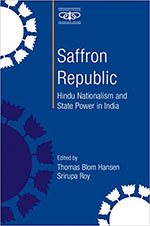This volume, divided into four sections, has thirteen carefully selected essays. It attempts at investigating the rise of ‘New Hindutva’ in India. This phenomenon has been defined by the editors as a ‘governmental formulation with considerable institutional heft that converges with wider global currents and enjoys an unprecedented level of mainstream acceptance’ (p. 1). They further explain that Hindutva now leads to many forms of group politics. New Hindutva develops through a dependent, devolved and elastic series of actions and events that are shaped by specific contexts and requirements and leads to a Hindu majoritarian social order.
In his study of the city of Aurangabad, Thomas Blom Hansen finds a social and geographical seclusion of Muslims which has led to the notion of Hindus as a modern and progressive community, thus facilitating the rise of Hindutva as a dominant common sense across the city. The communal division in the city is rooted in historical conflicts which hark back to the police action of 1948, which is seen by many Hindus as an act of liberation. But to the old Muslim elite, it reminds of an embarrassing defeat which started the process of their marginalization on all fronts. The industrial boom in the 1990s and 2000s in this area did nothing to bridge this chasm between the communities.

